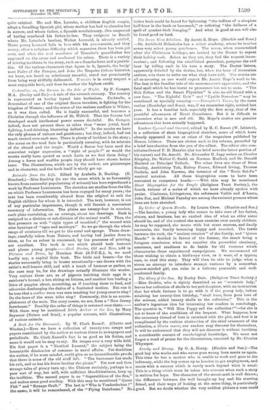Animals from the Life. Edited by Arabella B. Buckley. (E.
Stanford.)—Miss Buckley (to use the name which is so favourably known from successful popularising of science) has here reproduced a work by Professor Leatemann. The sketches are studies from the life, on which Professor Leatemann has been engaged for many years; the text has been considerably altered from the original to suit the English children for whom it is intended. The text, however, is not of any particular importance, though it will furnish a convenient summary of information. The plates are twenty-four in number, each plate containing, on an average, about ten drawings. Each is assigned to a division or sub.division of the animal world. Thus, the first presents us with "eight types of mankind ;" the second with nine figuringe of "apes and monkeys." So we go through the whole range of creatures till we get to the coral and sponge. These draw- ings, carefully taken from Nature, and having bad justice done to them, as far as colour is concerned, by the processes of printing, are excellent. The hook is one which should both instruct and please young people.—Bird Stories, Old and New, told in Pictures and Prose, by Harrison Weir (8.P.O.K.), is, we need hardly say, a capital little book. The birds and beasts—for the stories necessarily bring in beasts occasionally—are drawn with the artist's well-known skill, and with a touch of humour or pathos, as the case may be, for the drawings actually illustrate the stories. Very curious these are, as of pigeons hatching their eggs in a retriever's kennel, a hen sitting on kittens, and another hen leading a litter of puppies about, scratching, as if teaching them to feed, and otherwise discharging the duties of a feathered mother. But can it be true that a mother wren was seen teaching her young ones to sing ? Do the hens of the wren tribe sing ? Commonly, this is an accom- plishment of the male. The story comes, we see, from a "New Jersey farmhouse." Possibly the order of things is reversed over there.— With these may he mentioned Little Arthur at the Zoo, by Mary Seymour (Nelson and Sons), a popular account, with illustrations, of various animals.























































 Previous page
Previous page